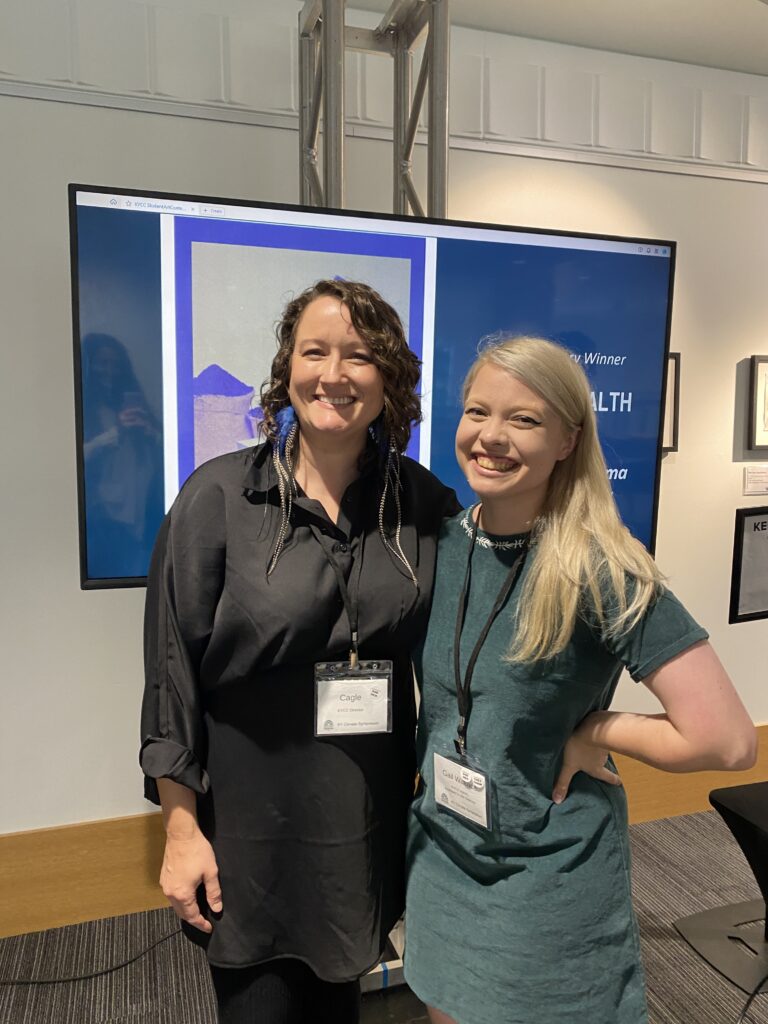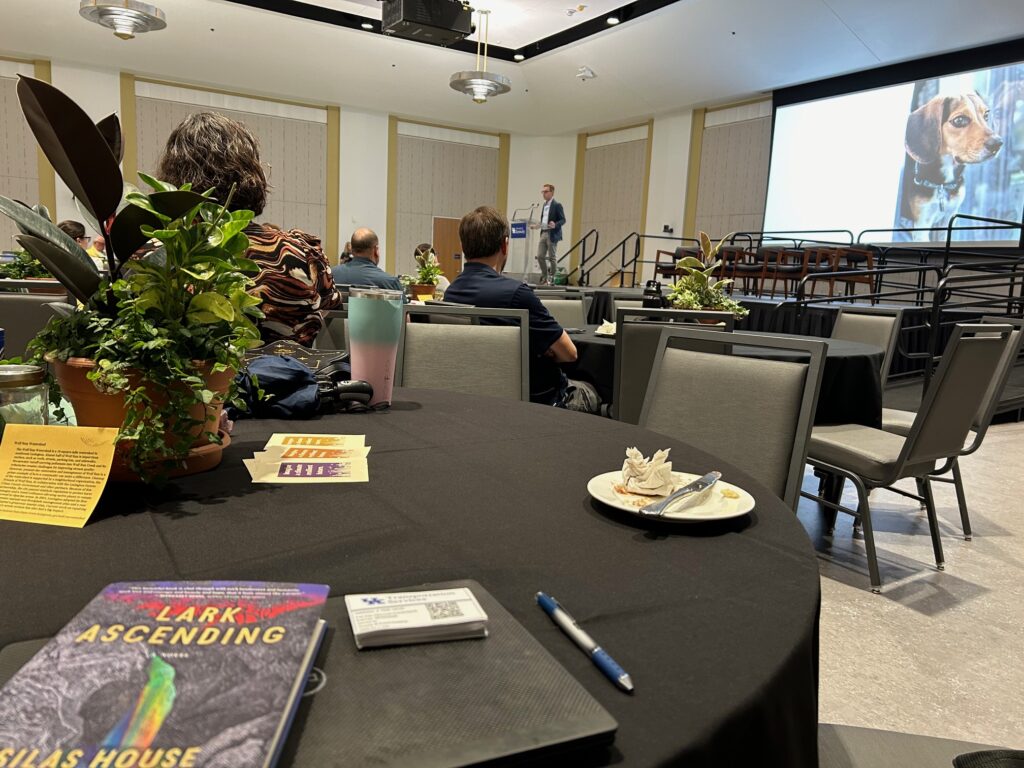On September 26, 2024, the Kentucky Climate Consortium made history by welcoming nearly 300 academic professionals, organizers, and community members to the Harris Ballroom in the Gatton Student Center at the University of Kentucky to discuss a myriad of topics centered around climate in Kentucky. Not only was the inaugural Kentucky Climate Symposium successful in building networks of connection and collaboration, but the symposium was also able to achieve zero waste.
According to Ryan Lark, Zero-Waste Specialist with UK Recycling, the estimated diversion rate for the event was 91%. A bulk of this waste diversion was due to composting (54%), followed by reduction, or the use of reusable dishware rather than disposables (34%), and recycling (4%).
The Kentucky Climate Symposium could not have achieved zero waste status without the guidance and support of UK Catering and UK Recycling, both of which being instrumental in the planning and execution of the event.


The KYCC Symposium this year included a student art contest, accepting submissions from any undergraduate or graduate student currently enrolled at least part-time at a college or university in the state of Kentucky. One winner was be chosen for each category, as well one runner-up. The annual open-all submission art contest was divided into four submission categories.
- 2D Art
- 3D Art
- Photography
- Open Category
Congratulations to this year’s chosen winners and runners-up!
Isaiah Flannery
2D Winner, Empty Ecosystem Starter Kit
Large, flat, carefully manicured grass lawns are a staple of households not only in Kentucky, but in suburban America as a whole. Unfortunately, the practice of maintaining a flat lawn of monoculture grass hurts local ecosystems. Grass lawns lack diverse food sources and shelter for wildlife, and at the same time worsen water scarcity and greenhouse gas emissions. All the while, the American lawn and garden industry makes money on marketing this unnatural “American Dream” to homeowners, selling the solution to a problem that they perpetuate. In this digital art piece, I appropriate the symbol of a bag of grass seed to critique the brands that make money off of it. By replacing marketing splash text with a typical lawn’s negative environmental impact, the insincerity of a “greenwashed” marketing strategy is emphasized. A muted gray-green background and plasticy package material further emphasize that insincerity. Similarly, the product isn’t advertised as “grass seed”, but 1 “grass lawn”. This is done to emphasize how lawn and garden companies aren’t selling nature or plants, but an idealized aesthetic for curb appeal. With this piece I hope to encourage suburban Kentuckians and Americans as a whole to critically examine the typical lawn and its contributions to climate change and habitat destruction. With the popularity of the Guerilla Gardening movement online through social media apps like Instagram and TikTok, I’m hopeful that the upcoming generations of Kentuckians will work hard to reintroduce diverse, healthy ecosystems to our unique state.
Jason Kash – University of Kentucky
2D Runner-Up, Ordovician Reverie
I have always been humbled by the landscape of Kentucky. Visiting Mammoth Cave growing up, I was in awe of how simple, natural forces shaped such a sublime space. To this day, it is difficult to imagine the expanse of time required for a river to carve solid rock into an amphitheater-sized space. Fast forward to moving to Lexington, I was stunned by the rock structure of the Red River Gorge, which felt like a different world than the rolling hills of western Kentucky where I grew up. The layers of rock at the gorge are like pages in a vast, closed book, whose secrets are concealed and revealed by the power of erosion. I feel fortunate to have lived in a place like Kentucky, where the thin veil of the present is so often punctured by the dramatic void of the past, leaving me speechless and with respect for the greater forces at play in all of our lives. I find creating art is a way of aligning myself with these forces and reveling in their beauty and power. My hope with creating art in this way is to ask others to reflect on the power of nature and arrive at a more humbled position. We are neither separate from nature nor dominant over nature. Yet, our society lives as if this is not true. This false belief is what I believe has led us to take the natural world for granted, which is now threatening our own existence in the deepest sense. With Ordovician Reverie, I am searching to connect with the distant past of Kentucky. Around 400 million years ago, Kentucky was under the ocean – an ocean with a plethora of life forms. At some point, a mass extinction event known as the Ordovician Extinction occurred, decimating the lifeforms of the ocean. However, these organisms’ lifeless bodies did not disappear; they now make up the limestone found throughout the state. By using plaster, a lime-based material, along with my own mark making, I am seeking to renew these ancient organisms with life while reflecting on how I am also destined to rejoin the earth.
Jason Kash – University of Kentucky
3D Winner, I-Beam (Husk)
I have always been humbled by the landscape of Kentucky. Visiting Mammoth Cave growing up, I was in awe of how simple, natural forces shaped such a sublime space. To this day, it is difficult to imagine the expanse of time required for a river to carve solid rock into an amphitheater-sized space. Fast forward to moving to Lexington, I was stunned by the rock structure of the Red River Gorge, which felt like a different world than the rolling hills of western Kentucky where I grew up. The layers of rock at the gorge are like pages in a vast, closed book, whose secrets are concealed and revealed by the power of erosion. I feel fortunate to have lived in a place like Kentucky, where the thin veil of the present is so often punctured by the dramatic void of the past, leaving me speechless and with respect for the greater forces at play in all of our lives. I find creating art is a way of aligning myself with these forces and reveling in their beauty and power. My hope with creating art in this way is to ask others to reflect on the power of nature and arrive at a more humbled position. We are neither separate from nature nor dominant over nature. Yet, our society lives as if this is not true. This false belief is what I believe has led us to take the natural world for granted, which is now threatening our own existence in the deepest sense. With I-Beam (Husk), I am imagining a future in which humanity and all its advancements have been reclaimed by natural forces. The creation of the steel I-beam has allowed for human expansion unlike ever before. Ever since the first skyscrapers, the I-beam has come to symbolize humanity’s triumph over nature, beckoning our immortality. However, when viewed on a geological timescale, steel inevitably withers away. In this work, I have casted iron, the main element in steel, into a wooden I-beam mold. Through this process, the form has taken on an organic and fragile nature, subverting the traditional image of the I-Beam. Much like an ancient Roman artifact, the casting’s presentation alludes to a time when the objects of our daily lives are considered history.
Elizabeth Roach – Murray State University
Photography Winner, Sludge
Sludge, while it appears disgusting to many it is actually important to the earth’s ecological balance. What is not important however is the oil in the water. Global warming is a crisis and part of it is oil spills and leaks. Even off the side of a small little road in a little town in Kentucky there is oil in the water. Oil in the water contributing to global warming and hurting the environment. Destroying our beautiful nature one little stream at a time.
Savannah Leach- Murray State University
Photography Runner-Up, Urban Symmetry
My photography explores the relationship between industrialization and nature. I capture contrasting scenes, such as a large metal pipe in a swamp with water and marsh life surrounding it. I aim to highlight the beauty and fragility of our planet’s ecosystems, provoke reflection on human intervention, and evoke reverence for the balance between industry and nature. Ultimately, I want to inspire responsible actions to preserve and protect the environment.
Lucas Carlos de Lima – University of Kentucky
Open Contest Winner, The Commonwealth Planter
As climate change becomes an ever-present aspect of our daily lives, some people take the pessimistic and apathetic point of view, but I find it extremely inspiring to see how many people become inspired instead of defeated by the reality we face. All the students around me are citizens who are, at the very least, aware of the current climate issues, however, most of my peers are so impacted by the idea our natural future might be denied that they choose to remain optimistic and adapt many aspects in our daily life to nurture a better tomorrow. My piece is a blueprint for a modular planter that can be built using any type of laser-cutting device, available in design schools and other technology centers around the Commonwealth. Much like the plants that will grow from the soil, my vision is that this blueprint might be a tool to nurture student’s minds on the impact even a small action, like having an indoor plant, might cause a change in the environment. My design for the planter can be cut from any sort of recycled material in a sheet format, therefore helping redirect waste from the environment towards a device that can not only teach children about sustainable living but also mitigate food insecurity.
Congratulations to the Kentucky Climate Consortium for achieving the remarkable milestone of being a zero-waste event! The commitment to sustainability sets a powerful example for others. The artwork on display during the event showcased creativity and reinforced the message of environmental responsibility. Together, these elements created an impactful event that celebrated ecological mindfulness. Well done!



























